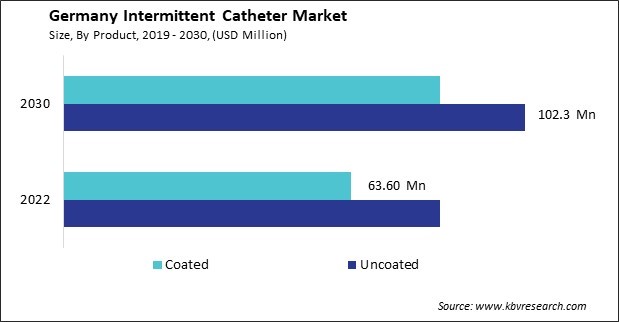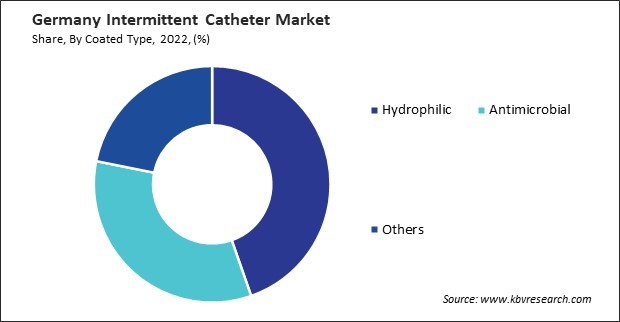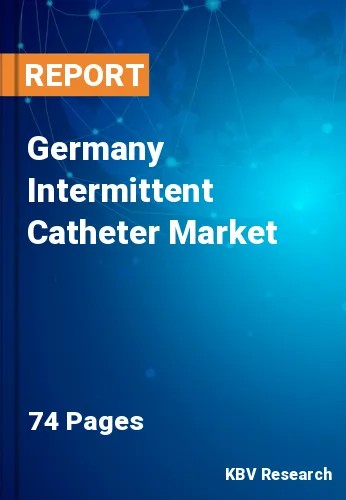The Germany Intermittent Catheter Market size is expected to reach $185.8 million by 2030, rising at a market growth of 3.0% CAGR during the forecast period. In the year 2022, the market attained a volume of 47,480.2 thousand units, experiencing a growth of 3.4% (2019-2022).
The intermittent catheter market in Germany, like in many other developed countries, has been influenced by factors such as an aging population, an increase in the prevalence of urological disorders, and advancements in healthcare infrastructure. Intermittent catheters are commonly used for individuals with urinary retention issues or those who have difficulty emptying their bladders. Elderly care and assisted living have become increasingly vital aspects of healthcare, especially in countries with aging populations, such as Germany. As life expectancy rises, so does the prevalence of age-related health conditions, including urinary issues that often necessitate the use of intermittent catheters.

The German healthcare system, known for its high standards and accessibility, has contributed to the growth of the intermittent catheter market. The availability of advanced medical facilities, well-trained healthcare professionals, and a strong emphasis on patient care have positively influenced the adoption of intermittent catheters in the country. Additionally, the German government's initiatives to promote healthcare infrastructure and ensure affordable access to medical devices have further fueled industry growth.
For patients undergoing rehabilitation, particularly those dealing with conditions such as spinal cord injuries, neurological disorders, or post-surgical recovery, urinary management is a significant aspect of care in Germany. Intermittent catheters are frequently employed to assist individuals who may face challenges with bladder function during their rehabilitation process.
The intermittent catheter market in Germany has witnessed significant growth, driven by an increasing aging population, and rising awareness about urological disorders. The pharmaceutical industry plays a crucial role in this scenario, as it actively develops and manufactures innovative catheter solutions. Companies in the pharmaceutical sector collaborate with healthcare professionals to design catheters that address specific German patient needs, ensuring comfort, safety, and efficacy. Moreover, advancements in materials and technology have led to the creation of user-friendly catheters, enhancing patient compliance and overall industry penetration.
The pharmaceutical industry's involvement extends beyond product development to encompass strategic partnerships and distribution networks. These collaborations enable pharmaceutical companies to efficiently reach end-users, including hospitals, clinics, and home healthcare settings. In the competitive German intermittent catheter market, pharmaceutical firms focus on research and development to introduce new catheter variants, ensuring they meet the highest quality standards. Government regulations and healthcare policies further shape the pharmaceutical landscape, emphasizing the importance of patient well-being and driving continuous improvements in intermittent catheter solutions in Germany.
According to Germany Trade and Invest, the pharmaceutical industry in Germany, from 2021 to 2022, grew by 10.5 percent – almost twice the growth of the overall pharma industry. Revenue from biopharmaceuticals in Germany reached EUR 17.8 billion in 2022, equivalent to one-third of the total pharmaceutical industry.
The substantial growth in the pharmaceutical industry indicates a thriving environment for innovation and diversification. Pharmaceutical companies invest in various healthcare solutions, including medical devices like intermittent catheters. This growth indirectly contributes to advancements and innovation in related sectors, such as medical devices, including intermittent catheters. Thus, the robust growth of Germany's intermittent catheter market is intricately linked to the proactive role played by the pharmaceutical industry in developing cutting-edge solutions tailored to the specific needs of the aging population.
In Germany, the intermittent catheter market has witnessed a notable surge in clinical research and development activities in recent years, reflecting a growing emphasis on advancing medical technologies to enhance patient care. The heightened focus on innovation is driven by the increasing prevalence of conditions such as neurogenic bladder disorders and spinal cord injuries, necessitating effective and efficient urinary management solutions. Researchers and healthcare professionals in Germany are actively exploring new materials, design improvements, and technological innovations to address the evolving needs of patients relying on intermittent catheters.
Researchers are exploring sustainable and biocompatible materials to enhance the safety and efficacy of intermittent catheters in Germany. Furthermore, there is a focus on developing smart catheter technologies, incorporating sensors and connectivity features to monitor and manage urinary conditions more effectively. These innovations aim to provide real-time data for patients and healthcare professionals, allowing personalized and timely interventions. The collaborative efforts in Germany underscore the commitment to addressing the evolving needs of patients with urinary issues, ensuring that the advancements in intermittent catheter technology are effective and aligned with the principles of patient comfort, hygiene, and long-term usability. Hence, the emphasis on sustainable materials, smart technologies, and collaborative efforts reflects a dedicated pursuit of effective, patient-centric solutions for improved urinary management and overall well-being.

The intermittent catheter market in Germany is characterized by a competitive landscape with several companies actively contributing to developing, manufacturing, and distributing these medical devices. B. Braun is a globally recognized healthcare company with a strong presence in the intermittent catheter market. The company offers a range of urology products, including intermittent catheters designed for comfort and ease of use. The company focuses on innovation and patient-centric solutions, contributing to its prominence in the German industry.
Wellspect HealthCare, operating as part of the Dentsply Sirona group, is a local player in the German intermittent catheter market. The company focuses on urology and continence care, offering innovative solutions, including intermittent catheters. Wellspect HealthCare is dedicated to improving the quality of life for individuals with bladder-related conditions through its locally tailored products.
While Teleflex is a global company, its German subsidiary, Teleflex Medical GmbH, plays a vital role in the local intermittent catheter market. The company is committed to addressing the specific needs of German patients, providing a range of urological products, including intermittent catheters. The local presence allows Teleflex to adapt its offerings to the unique requirements of the German healthcare system.
Lofric GmbH is a German company specializing in urological products, including intermittent catheters. As a local player, Lofric understands the nuances of the German healthcare system and tailors its products to suit the preferences and needs of the local population. The company emphasizes user-friendly designs and patient comfort in its catheterization solutions.
Becton Dickinson (BD) is a global medical technology company in Germany. Although an international company, BD often tailors its products to regional healthcare needs. BD's expertise in medical devices and commitment to advancing healthcare could extend to the intermittent catheter market in Germany.
By Product
By Indication
By End User
By Category
Our team of dedicated experts can provide you with attractive expansion opportunities for your business.

